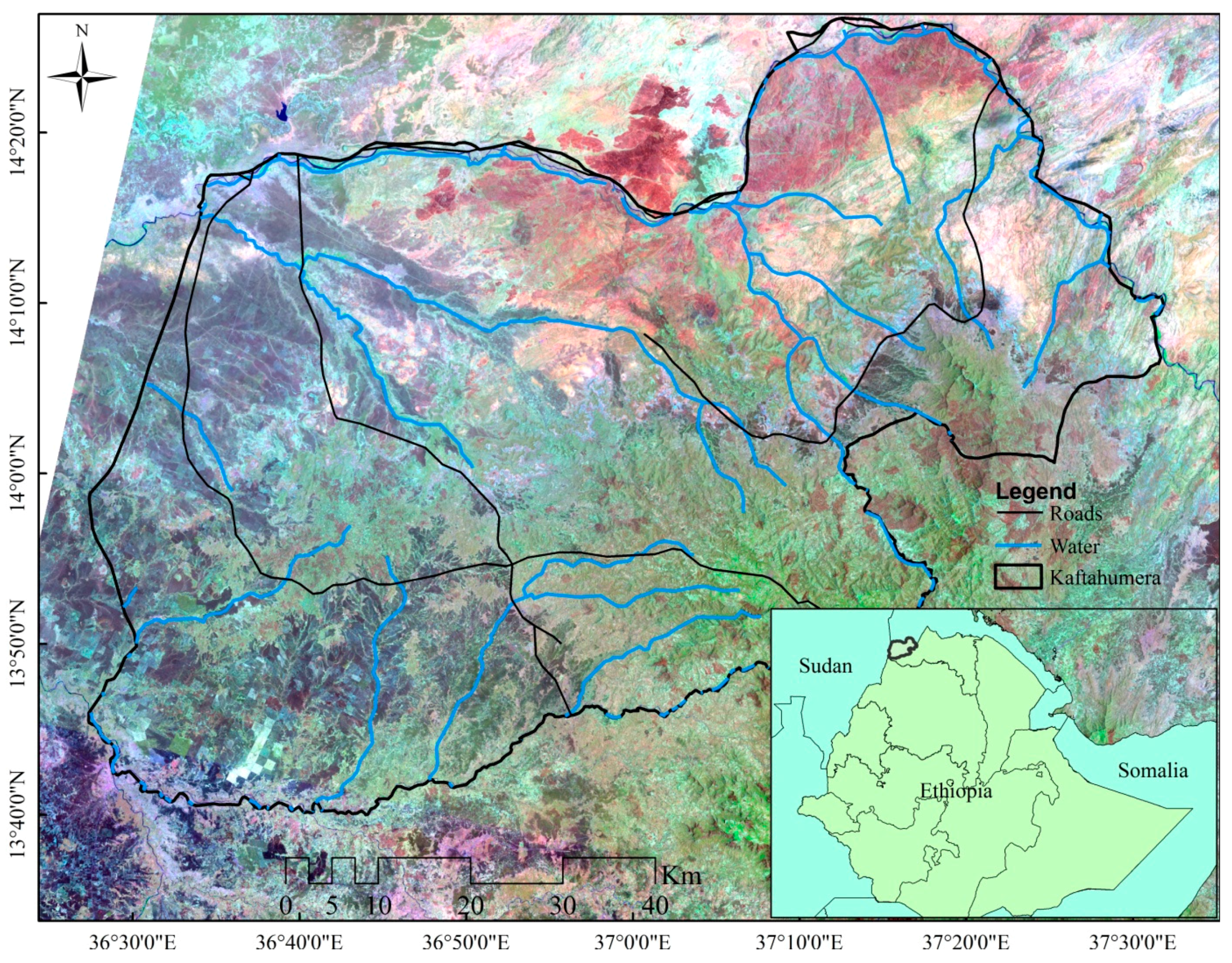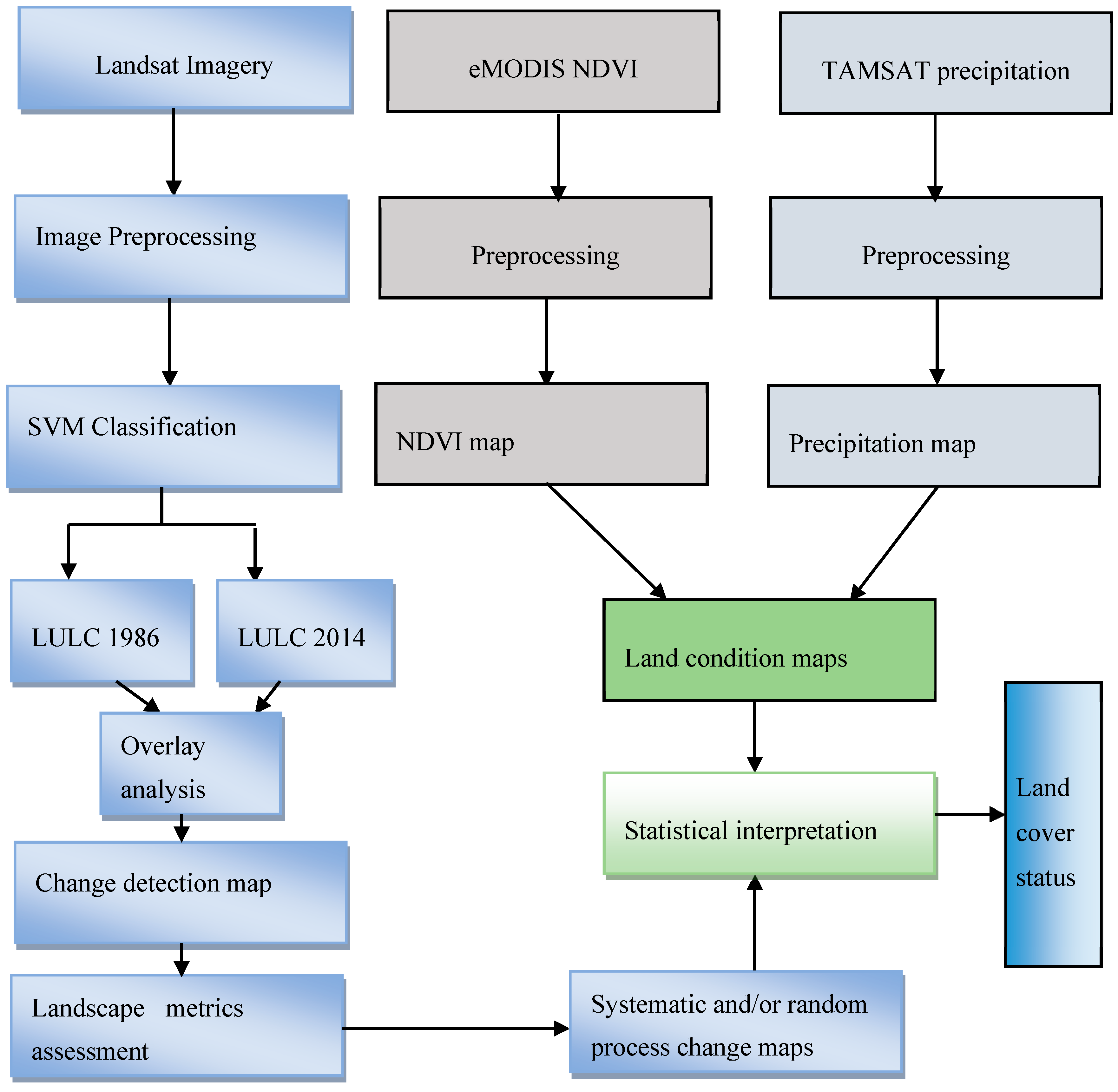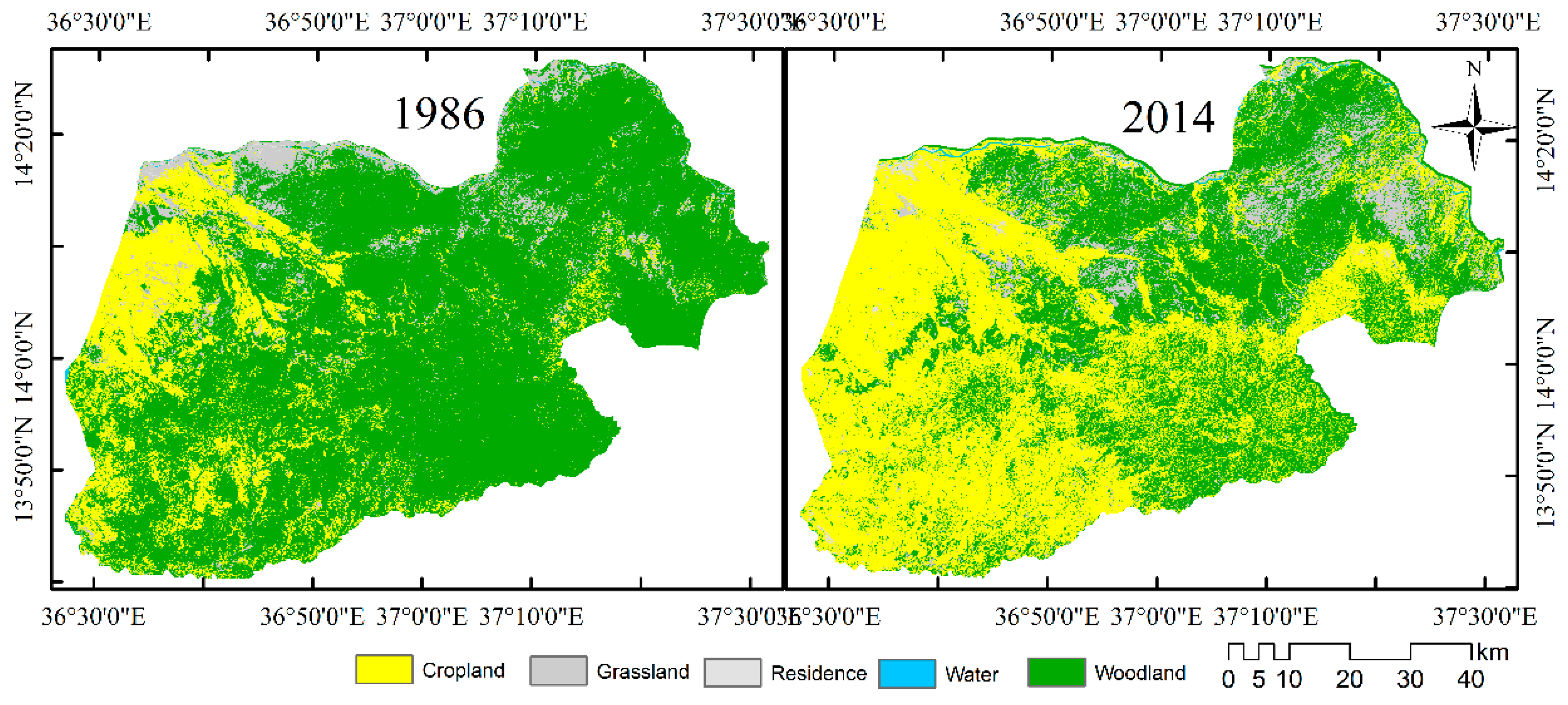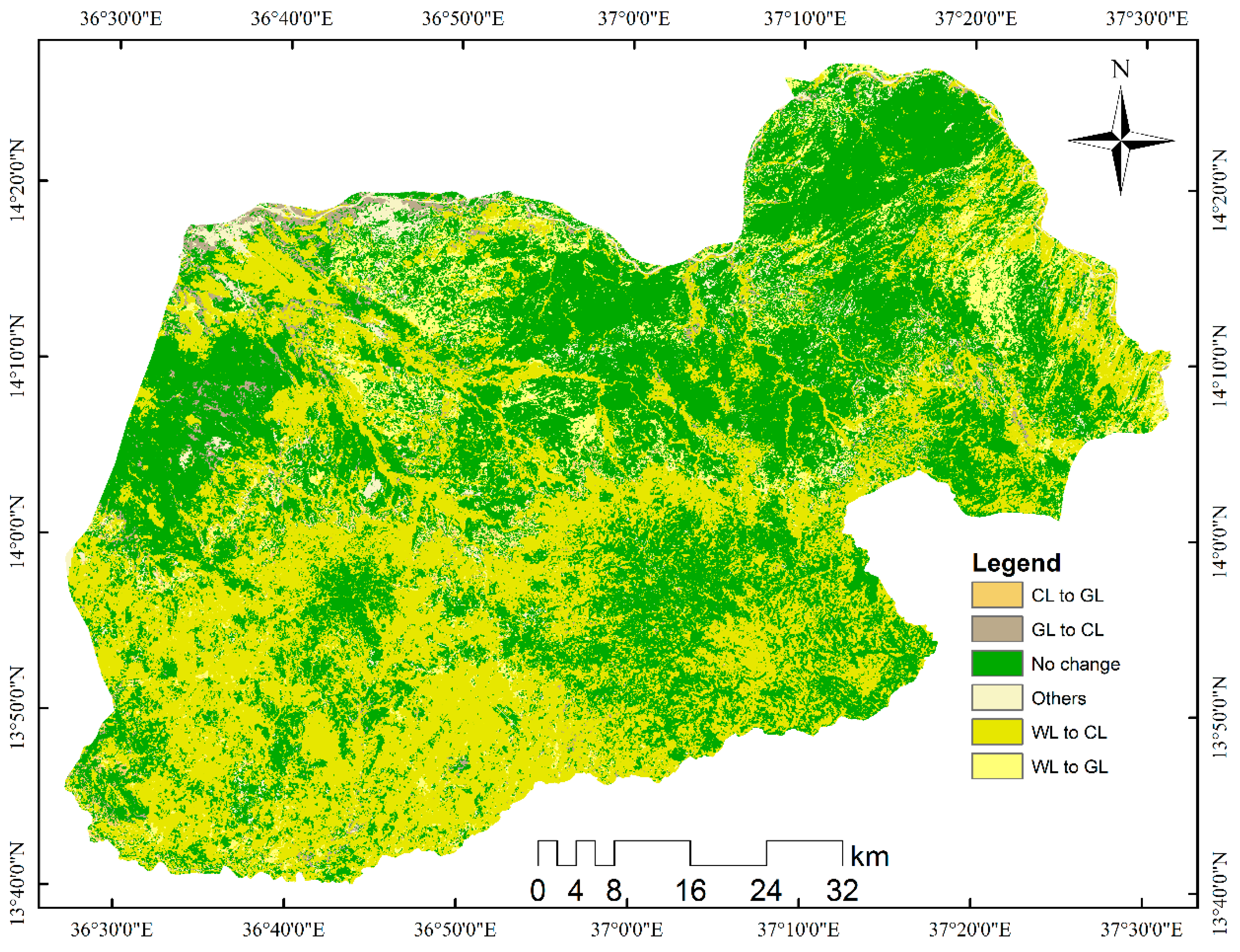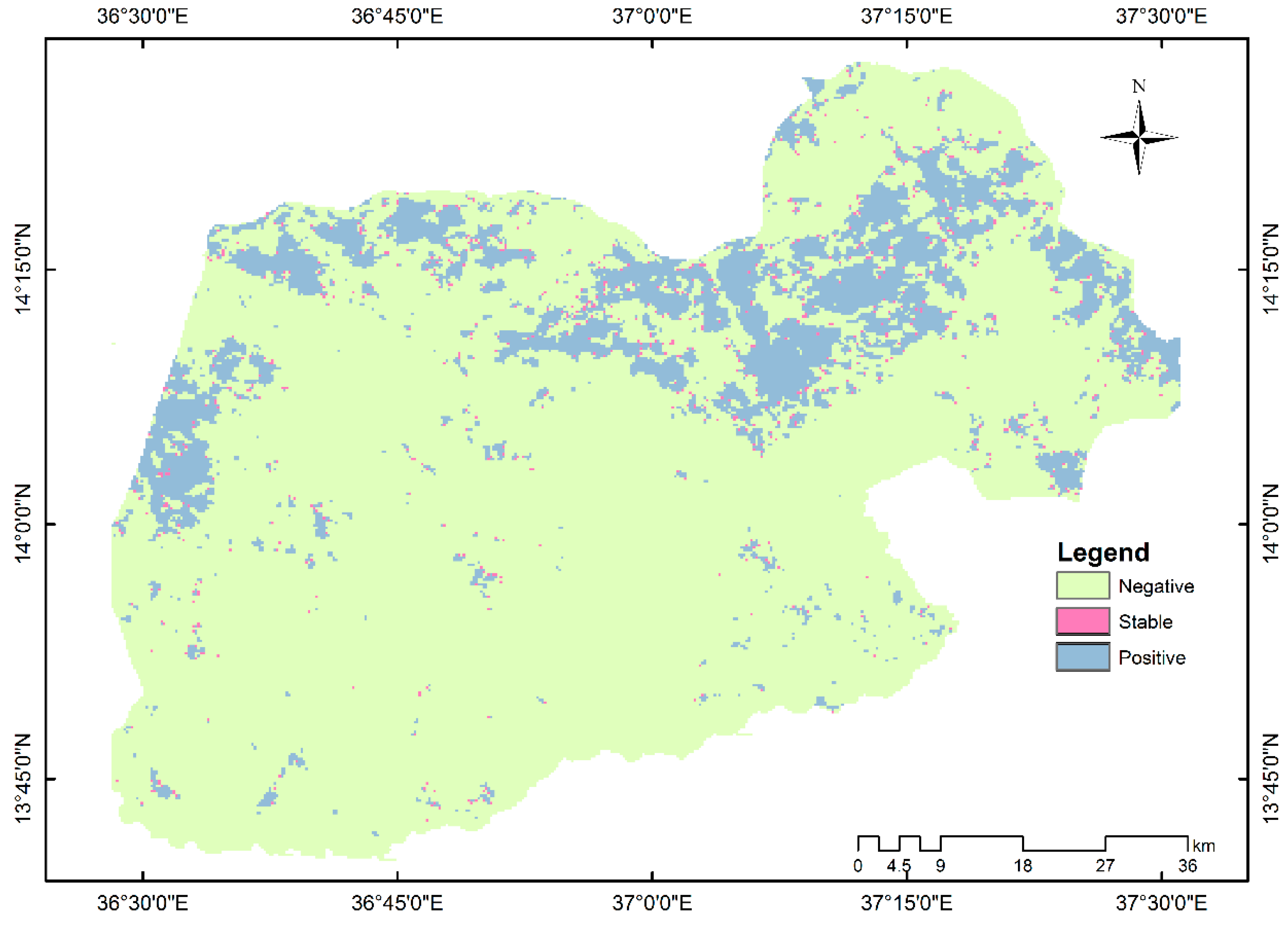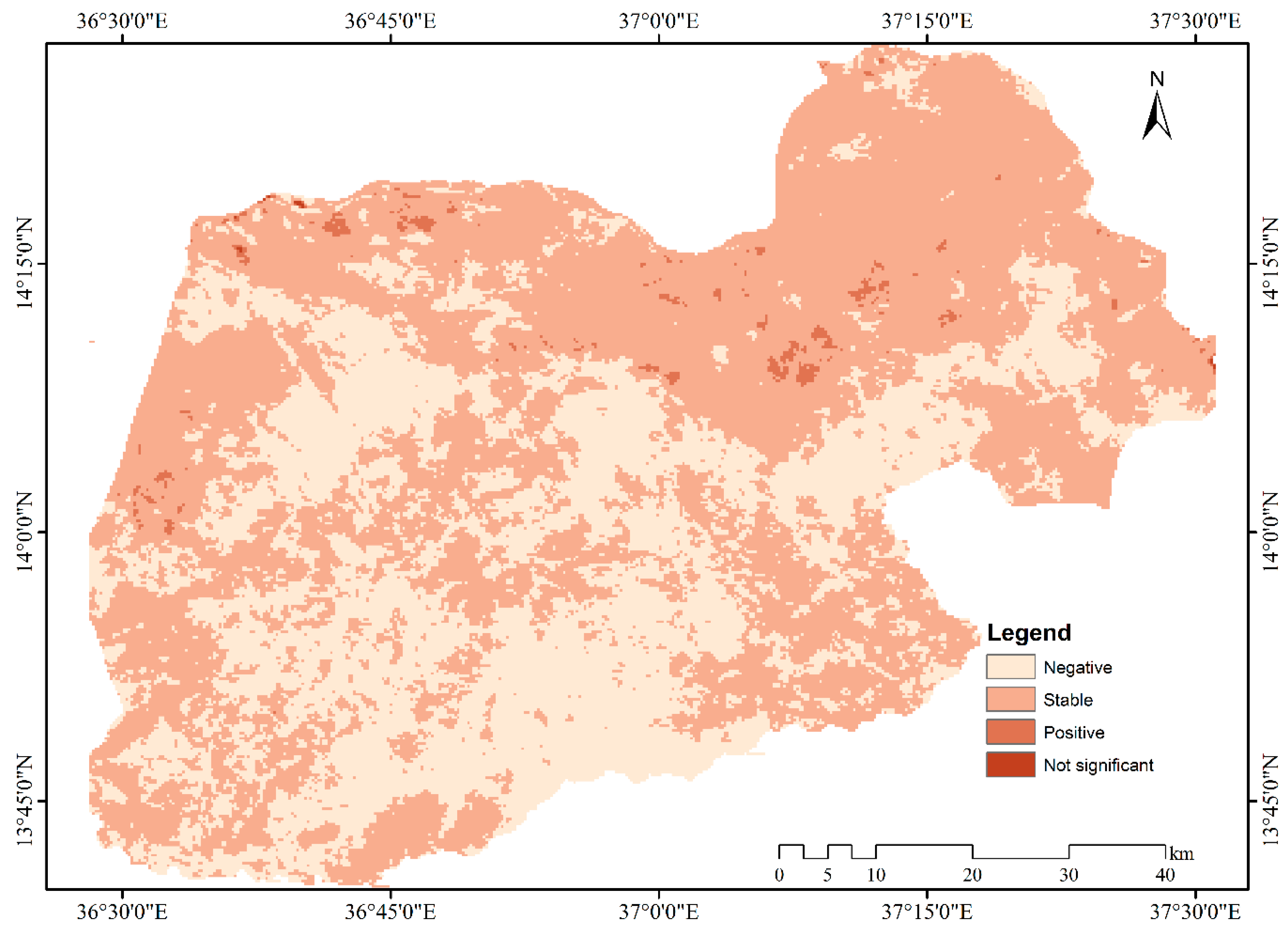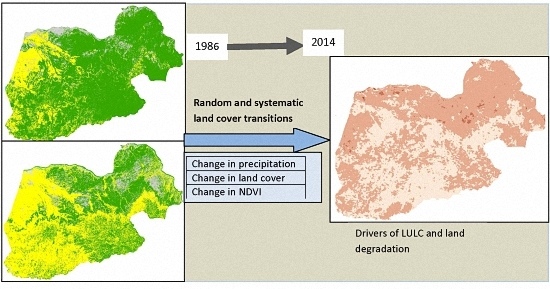1. Introduction
The anthropogenic endeavors on dryland ecosystems expose tropical woodlands to degradation, deforestation and loss of soils [
1]. The loss in dryland vegetation of Africa has been significantly increased, resulting in land degradation [
2,
3]. The northwestern semiarid lands of Ethiopia are no different, as woodlands are cleared and exposed to severe landscape changes [
4,
5,
6]. The woodlands of Ethiopia, despite their richness in biodiversity, are shrinking in size due to the pressure of anthropogenic activities [
5,
7]. Global assessment of land degradation indicated that more than 26% of the country has already been degraded, and the livelihood of about 30% of the population in the period 1981–2003 has been affected [
8]. The annual deforestation rate of Ethiopia is estimated at about 2%, with woodland loss being prevalent due to the resulting pressure from population growth and cropland expansions [
9]. The population size of the country has more than doubled in the last three decades from 40 million in 1984 to over 87 million in 2014 [
10]. Due to the severe land degradation of highlands, population resettled to the lowlands of the country, which brought a significant threat to woodlands [
5].
Land use/land cover (LULC) change assessment of drylands is gaining more consideration by global environmental change studies as land use modification is exposing them to transitions and high rates of resource depletion [
11]. LULC studies focused on understanding the patterns, processes and dynamics of land transitions and its drivers over time [
12,
13,
14,
15,
16]. The processes of these land use transitions can be categorized into either random or systematic changes based on identifying their pattern of categorical changes [
12,
17]. A random process of change occurs when a LULC category loses to or gains from other categories in proportion to the size of other land cover categories, while systematic transitions are driven by the regular processes of transition that change in a constant or gradual development [
12,
14]. Post-classification comparison (PCC) is among the change detection approaches that can be used in order to determine changes between satellite imagery of different sources and dates [
18,
19].
PCC utilizes a transition matrix comprising two-date imagery to investigate the net change among the land use categories [
12,
20]. However, the analysis of net change alone may not describe the total change, as there might be zero net change due to a simultaneous gain and loss of a land use category within the landscape [
12]. It is also vital to discriminate the significant signals in the process of categorical land use shifts [
17]. The identification of systematic land use changes
versus a random process of change is helpful in determining the severity of land use transitions for proper land use planning. The existence of larger areas of change may not always indicate systematic land use shifts, as large land use shifts may occur in large land use classes in a random process of change [
12]. Hence a detailed change analysis matrix provides an understanding to identify the process of change within the landscape [
17].
The remarkable changes in agricultural practices and open access to woodlands have been the main driving forces for the loss in vegetation cover, which can result in land degradation [
5]. However, mapping land use shifts through identifying random or systematic process of change was not made for the northwestern drylands of Ethiopia. In order to sustainably utilize the existing resources, there is the need for the broad consideration of LULC for the timely inspection of the transitions of landscapes [
21]. Satellite imagery contributes significantly to the spatiotemporal evaluation and documentation of the modifications of landscapes over time [
14,
15]. Hence, this study: (1) quantifies the signals of land use transitions; (2) identifies the consequences of land use change; (3) identifies the spatial association of precipitation and NDVI for a better understanding of the threats of dryland environmental changes.
3. Results
3.1. Land Cover Transition
Figure 3 illustrates the temporal transitions of land use categories in the period 1986–2014. There is a significant amount of spatial changes among the land use classes in the study period. In 1986, woodland is the dominant category covering about 79% of the landscape. However, the dominance of woodland was replaced by cropland, in which cropland acquired more size in 2014 dominating over 53% of the landscape with a net gain of about 40%. Hence, cropland has the highest gain to loss ratio (g
l = 19.8) among the land use classes signifying about 20-times extra growth in size than loss in relation to the increase in other land use categories. Woodlands are the most important contributors for the newly increasing croplands. Grassland has acquired a total transition of about 14% with a net increase of nearly 4%. During the study period, over 55% of the loss in valuable ecosystems detected within the landscape was mainly due to the loss of the native woodlands.
3.2. Persistence in the Landscape
The temporal changes in the period 1986–2014 for all land cover classes are shown in
Figure 4. In this period, nearly 54% of the landscape has shown a transition from one land use category to a different category. However, about 10% of this transition occurred due to swap change, in which there existed a coinciding gain and loss among the land use categories. During the study period, the persistence of the landscape shares only about 46% of the area, whereas the largest proportion experienced land use shifts (
Table 4). Woodland experienced the uppermost persistence of about 32%. However, the dominance in the persistence of woodland during the study period is mainly due to its higher proportion in 1986 covering 79.0% of the landscape. This land use class suffered the highest loss among the land use categories with a net loss of about 44%. On the other hand, cropland got a significant increment in size covering about 53% of the landscape in 2014. It has also the lowest amount of loss (2%) and a persistence of over 11%.
Results of a g
p ratio greater than one indicate the highest likelihood of a land use class to enlarge compared to its initial size [
12] (
Table 5). Accordingly, cropland, grassland and residence all have a g
p value of more than one, demonstrating their trend to grow in comparison to their original extent of 1986. On the other hand, woodland and water have a value of below one, signifying that the size of added extent is less than the size of their unchanged extent.
The ratio of lp larger than one designates the inclination of a category to be exposed to transition rather than persistence during the period of the assessment [
12]. Among the land use categories, residence and cropland have lp ratios of below one, displaying their lower amount of loss in comparison to the unchanged extent. This is an indicator that their tendency of loss is minimal with a better chance of expansion than loss. In contrast, woodland and grassland have l
p ratios of above one, showing their exposure to transition. This has been confirmed by a significant amount of loss of woodlands along the study period. However, the higher value of grassland is attributed to its higher swap changes of both gain and loss.
The net change to persistence (np) is negative for woodland and water, indicating their net loss compared to their persistence. The loss in water may be related to the shrinkage of water bodies due to the expansion of croplands in woodland and wetland areas in the study area. The np of cropland is larger than three and demonstrates a net expansion of about four times its extent in 1986. Grassland also experienced a net increase in size, but it also shows a comparable loss in the same period. The size of built-up areas also significantly increased, having an np of 2.4. The expansion of built up areas is related to an increase in residential areas attributed to the demographic change occurring within the region.
3.3. Net Change and Swap Change
The land use transition is complemented by gross gains and gross losses among the land use categories in the study area. Woodland has a gross loss of about 47%, while cropland has a gross gain of 42% (
Table 4). The net change of woodland and cropland is 44% and over 39%, respectively. Among the land use categories, grassland showed a significant amount of swap change of over 9% related to other land use categories. Water and residence have the lowest swap change among the land use categories. The net change within the landscape is 44%, whereas the observed total change is about 54%, proving that both swap change and net change are vital to recognize the total transitions within the landscape. An analysis of land use transition considering only net change weakens the existing total changes of the ecosystem. There are swap changes during the study period that needs consideration due to both gain and loss in different locations.
3.4. Inter-Categorical Transitions in the Landscape
The LULC shift in the landscape under a random process of gain is shown in
Table 6 highlighting observed land use categories in bold, expected changes in italics and the change between the observed and expected proportion in normal font, respectively. The comparison of observed and expected proportions identifies and separates the random process of change from the systematic change based on the deviation of their values from zero. Accordingly, when the values of their difference approach zero, the transition is considered as a random process of change, whereas if the values are farther from zero, the change is systematic [
12]. Woodland has the highest loss compared to other land use types. However, the higher value of loss in woodland is not sufficient to decide that the change was systematic, as woodland is the dominant land use category within the landscape during the first point in time of the study in 1986. The systematic transition can be identified by interpreting the transitions with respect to the size of the categories.
During the evaluation of observed transition and expected transition under a random process of gain, it was found that observed gains for some land use categories are farther from zero. The difference between the observed and expected proportion of change of woodland to cropland under a random process of gain is 1.7%, which means that cropland systematically gains to replace woodland. The difference between cropland and woodland is −1.4%, as woodland systematically does not gain from cropland. The difference between observed and expected gains for grassland-cropland is −0.8%, which means that if cropland gains, it does not replace grassland. On the other hand, the difference between cropland-grassland is 0.2%, indicating a systematic transition of cropland to grassland. The difference between the observed and expected gains for woodland-grassland is −0.2%, implying that when grassland gains, it systematically does not gain from woodland. On the other hand, the difference between grassland-woodland is 0.9%, which means that woodland gains systematically from grassland.
The same comparison of the difference between observed and expected losses under a random process of loss is shown in
Table 7. The differences for woodland-cropland, cropland-grassland and grassland-residence are 1.3%, 1.0% and 0.2%, respectively. Hence, when woodland loses, cropland systematically replaces it; when cropland loses, grassland systematically replaces it; and when grassland loses, residence systematically replaces it. The difference between observed and expected losses for woodland-grassland and cropland-woodland is −0.9% and −0.9%, respectively. This implies that woodland does not systematically lose areas to grassland and that cropland does not systematically lose to woodland.
3.5. Land Degradation in Drylands of Northwestern Ethiopia
The bitemporal change assessment of Landsat imagery is augmented by temporal NDVI and precipitation analysis for detecting land condition. Accordingly, a pixel-wise regression analysis between precipitation data and NDVI was applied to investigate the spatial relationships of vegetation patterns and precipitation over the whole study area (
Figure 5). The result shows a high spatial non-stationary relationship between precipitation and NDVI within the landscape. The coefficient of determination (R
2) between precipitation and NDVI demonstrates a major difference in spatial distribution, with about 55% of the study area having low R
2 values of below 0.5. The spatial pattern of R
2 between precipitation and NDVI corresponds to the status of the vegetation condition. NDVI measures vegetation conditions considering the temporal biomass accumulation and its historical changes [
66]. The low correlation between precipitation and NDVI is a sign of loss in biomass accumulation. Similar studies in other drylands also indicate lower correlation of NDVI and precipitation due to loss of vegetation cover [
67,
68].
Among the land cover categories, mainly woodland areas converted to cropland show the lowest R
2 values between the points in time of 2000 and 2014. The northern part of the study area, which is covered by undisturbed woodland and grassland, shows R
2 of over 0.5. The lower spatial relationship of NDVI and precipitation in the study area is an indicator of disturbances that can be attributed to the deforestation of the woodlands [
67]. The inter-categorical analysis of Landsat imagery also identified conversion of over 39% of woodland to cropland as a dominant signal of change in the landscape within the period of 1986–2014. The loss in vegetation cover is an indicator of land degradation, especially in semiarid areas like of Kaftahumera.
The spatiotemporal linear regression analysis of the slope of the annual sum of NDVI is illustrated in
Figure 6. The slope is a measure of the direction and strength of annual NDVI variation from 2000–2014, in which a negative slope depicts a reduction in vegetation productivity over the study period. The assessment shows a significant reduction in the productivity of vegetation in most parts of the study area. The temporal reduction in NDVI resulted from the change in the spatial distribution of the woody vegetation and other human-induced changes in the ecosystem. The woodlands of Kaftahumera are affected by human activities, mainly due to cropland expansion, wood harvesting and resettlement, and show a significant reduction in vegetation productivity with negative trends in areas where settlement and cropland were expanding.
The spatiotemporal linear regression coefficient of annual cumulative NDVI is shown in
Figure 7 in order to investigate the significance of the undergoing changes. The outcomes indicate that most parts of the study area have shown a decrease in vegetation productivity (
p < 0.05) over the last 15 years. The reduction in NDVI values is a prominent indicator of loss in biomass accumulation, which ends up in woodland degradation [
54]. The majority of woodland areas, with human-dominated activities, like cropland and settlement, have shown significant changes in annual cumulative NDVI temporal trends. The NDVI analysis is in agreement with the respective Landsat image classification outputs, which prove a conversion of most of woodland vegetation to croplands. The deforestation and degradation of the woodlands result in lower vegetation productivity and, hence, in a negative NDVI trend.
The spatial correlation of precipitation over the period 2000–2014 is not significant at the 95% confidence level (
p < 0.05) (
Figure 8). Dryland vegetation productivity of Ethiopia is mainly determined by the availability of water than other climate variables [
69]. It is evident that the reduction in NDVI over woodland areas is not a result of change in precipitation distribution. The absence of significant trends in precipitation over the 15-year period is another indicator of anthropogenic factors that contributed to the decreasing vegetation productivity in the study area.
4. Discussion
This study used Landsat imagery, precipitation data and NDVI for identifying systematic and gradual land use changes and spatial mapping of land degradation in semiarid regions of northwestern Ethiopia. The lack of reference data that can be used for training and testing samples during image classification makes it difficult for historical imagery classification. The classified imagery was visually inspected for the identification of errors comparing to the imagery of 1986. The misclassified areas were relabeled to minimize the misclassification errors. This has improved the comparison of the classified bitemporal imagery for identification of land use transitions in the period of 1986–2014.
There is a pertinent systematic land use transition from woodland to cropland, as cropland is systematically gaining from woodland. LULC change assessment of the region shows that about 54% of the area underwent a transition between natural and human-dominated activities. Woodland suffered the highest net loss of about 44%. This significant reduction in the size of woodland cover is attributed to proximate causes of cropland expansion and overharvesting of woodlands and underlying causes, like population growth, policy changes and economic factors [
5]. The agricultural investments are favored with several incentives that include the least expensive land rent, exemption of the payment of income tax for up to five years and loans of up to 70% of the project cost [
70]. This has attracted over 400 agricultural investments to work on crop production within the region. Several studies in east Africa also showed the conversion of forests to agricultural lands affecting the diversity of woody vegetation and resulting in forest degradation [
69,
71,
72]. In Ethiopia, cropland expansion is one of the dominant driving factors of forest loss [
5,
69]. Image analysis confirmed the conversion of about 47% of the woody vegetation to other land use types affecting the natural vegetation. The intensive mechanized farming, mainly for the production of oil crops for international markets, has contributed to the shrinking of the woodlands [
4,
5]. In addition, the expansion of subsistence agriculture with ever-increasing population pressure competes with the natural vegetation.
There is no significant trend in precipitation, but a decline in NDVI is observed in the time period of 2000–2014. In the absence of human intervention, NDVI is positively correlated with the annual sum of precipitation. Hence, the reduction of vegetation productivity has to be attributed to the loss of vegetation cover and not to a decline in moisture, as moisture is the main constraint for vegetation growth in the drylands of Ethiopia [
69]. The reduction in biomass accumulation is a result of deforestation and degradation of the woodlands of the region mainly due to anthropogenic activities, substantiating the existence of land degradation. The removal of the protective cover leaves the soil highly vulnerable to wind erosion, particularly during the dry period of the year. The Sudano-Sahelian region is known as a source of soil-derived aerosols, which are aggravated due to climate change and vegetation loss [
73]. In recent years, it is common to observe dust clouds hovering over the northwestern regions of the country originating between the borders of the northwestern dryland of Ethiopia and Sudan [
74]. The occurrence of these dust clouds can be linked to the loss of vegetation cover, which hampers the topsoil movement due to wind erosion. Hence, dryland vegetation loss contributes to land degradation, exposing the inherently weak topsoil for both wind and water erosion [
75]. Deforestation of woodlands and loss of topsoil are large sources of anthropogenic greenhouse gases, mainly CO
2 emissions, that contribute to the loss of carbon from both woody biomass and soil, which can lead to land degradation and reduction in ecosystem services [
76,
77].
5. Conclusions
The significant amount of spatial changes among the land use classes during the period of three decades mainly contributes to an ongoing degradation of woodland ecosystems. In 1986, woodland was the dominant land use category covering about 79% of the area. However, the dominance of woodland reshuffled with cropland, as cropland acquires the largest extent in 2014 covering over 53% of the total area with a net gain of about 40%. The net change within the landscape is 44%, while swap change accounts for about 10% of the transition.
The LULC transition matrix of land cover categories under a random process of gain identifies that cropland systematically gains to replace woodland, while woodland systematically avoids gaining from cropland. This approach is helpful in detecting and analyzing the quantitative and qualitative dynamics of loss of valuable ecosystems for prioritizing better options of management of the semiarid environment. The replacement of woodland vegetation by cropland exposes the topsoil to wind erosion, and it is common to observe dust clouds during the dry period of the year.
The loss of woodland vegetation is an indicator of ecosystem degradation within the region. The spatial correlation of NDVI and precipitation shows R2 values of less than 0.5 in over 55% of the study area during the period 2000–2014. The temporal change in precipitation is not significant, but there is a negative trend in NDVI in areas of woodlands converted to cropland. The lower value of R2 between NDVI and precipitation is an indicator of land degradation due to the low response of degraded landscapes to precipitation. A result of this research indicates a systematic land use transition caused by human impact and calls for proper measures to combat ecosystem degradation.
